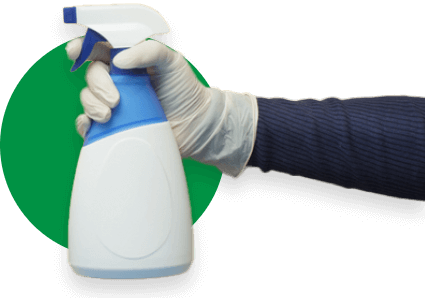Maintaining your commercial tile floors ensures a spotless and professional environment for employees and customers. Not only does cleanliness enhance the floors’ appearance, but it also extends the overall lifespan of your flooring.
Neglecting proper cleaning techniques can lead to unsightly stains and wear over time, which can be costly to fix. Dirty tile floors may give clients a negative first impression, affecting the overall image of your business.
We’ll guide you through how to clean commercial tile floors using the right cleaning products and correct techniques to ensure your commercial tile floors stay pristine.
What Is Commercial Tile Flooring?
Commercial tile flooring refers to a hard-surface flooring material in business settings. These tiles are designed to withstand heavy foot traffic and are popular with businesses due to their resilience and aesthetic appeal.
Tile floors are extensively used in many commercial settings, including offices, retail stores, restaurants, healthcare facilities, and hotels. The tile is easy to clean and offers a professional and sleek look that enhances the overall ambiance of the space.
Types of Commercial Tile Flooring
It’s important to make an informed decision when selecting the right tile for your commercial space. These are three of the most common types of tile flooring:
Ceramic Tile: Ceramic tiles are made from clay and other natural materials, which are then fired at high temperatures.
While luxury vinyl tile (LVT) has taken the market by storm, offering a cost-effective alternative to tile, ceramic tile still accounts for more than 14% of flooring sold in the U.S.
Ceramic tiles serve as decorative wall features in homes, offering easy-to-clean surfaces for kitchens, bathrooms, and more. They are also popular in swimming pools, walls, and rooftops.

Porcelain Tile: Porcelain tiles are a subtype of ceramic tiles known for their increased durability and resistance to moisture. Though pricier, porcelain is significantly harder than regular ceramic tiles. It’s suitable for areas prone to spills, like kitchens and bathrooms.

Natural Stone Tile: Natural stone tiles, such as marble, granite, and slate, offer a unique and luxurious appearance. While they require more maintenance, they are often chosen for upscale commercial establishments seeking a sophisticated ambiance.
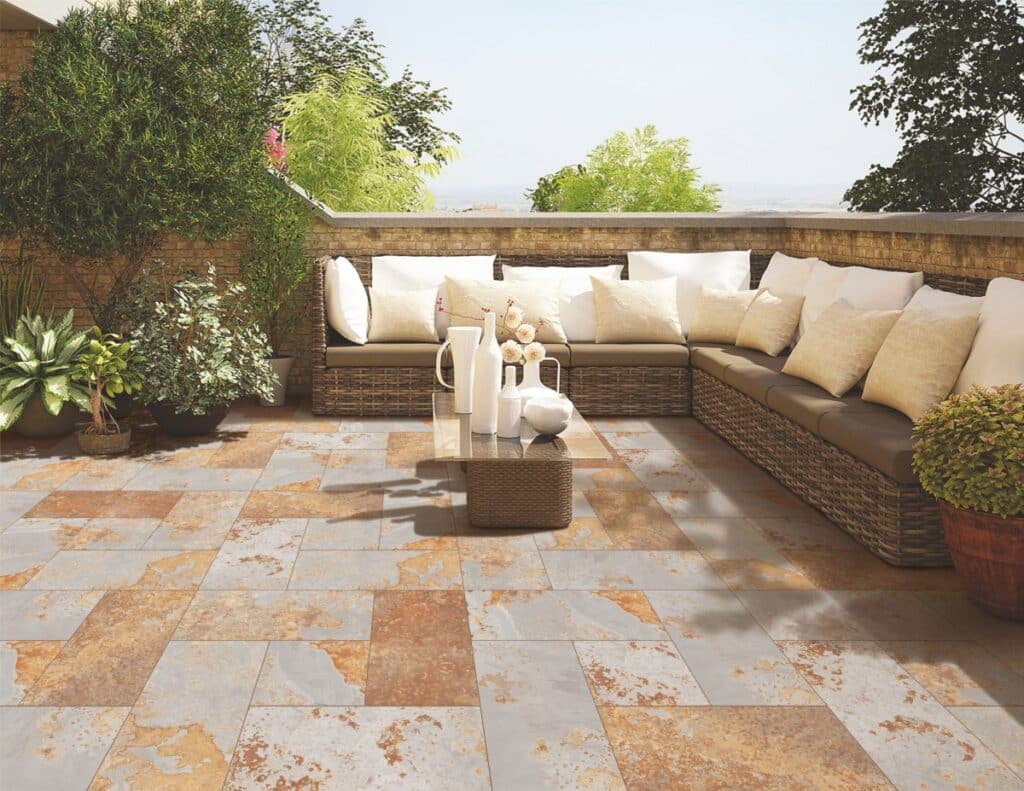
Choosing the Right Tile Cleaning Products
It’s important to use the correct cleaning products for your commercial tile floors to avoid damage and achieve effective cleaning. The wrong product can leave residue, dull the shine, or even harm the tile material, leading to costly repairs.
Below, we’ve broken down some of the most common tile-cleaning solutions:
- Neutral pH Cleaners: These gentle cleaners are suitable for regularly maintaining ceramic tile floors. They’re the best to clean tile floors on a routine basis.
- Alkaline Cleaners: Alkaline cleaners are more potent and tackle tougher stains and dirt buildup. They work well on ceramic tiles but should be used sparingly to avoid damaging grout.
- Acidic Cleaners: These cleaners are designed for natural stone tiles like marble and granite. Using acidic cleaners on ceramic tiles can result in etching and damage.
- Specialty Cleaners: Some commercial tile floors may require specialized cleaners that are designed for removing heavy grease in restaurant kitchens. Ensure you choose a product that matches your specific needs.
- Eco-Friendly Options: Consider environmentally-friendly cleaning products, like vinegar and baking soda, for a sustainable approach to tile maintenance.

How to Prepare Your Tile Floors for Cleaning
Follow these essential prep steps to ensure a thorough and effective cleaning process.
- Gather the Right Cleaning Products: Ensure you have the appropriate cleaning products based on the type of your tile floor. Having the right cleaning agent is essential for achieving optimal results.
- Clear the Area: Remove all furniture, rugs, and obstacles from the tile floor area. This step allows you to access every inch of the floor.
- Sweep or Vacuum: To start, use a broom or vacuum to remove any loose dirt, dust, or debris from the tile floor. Doing this keeps these particles out of the way during cleaning. For tile floor cleaning, you can remove most of the dirt through vacuuming alone.
- Address Stains or Spills: If there are noticeable stains or spills on the tile floor, consider pre-treating them with the appropriate stain-removing solution. This can help loosen tough stains before you begin cleaning.
- Ventilate the Area: Open windows and doors to ensure there’s adequate airflow during the cleaning process, which can help with drying and prevent inhaling fumes.

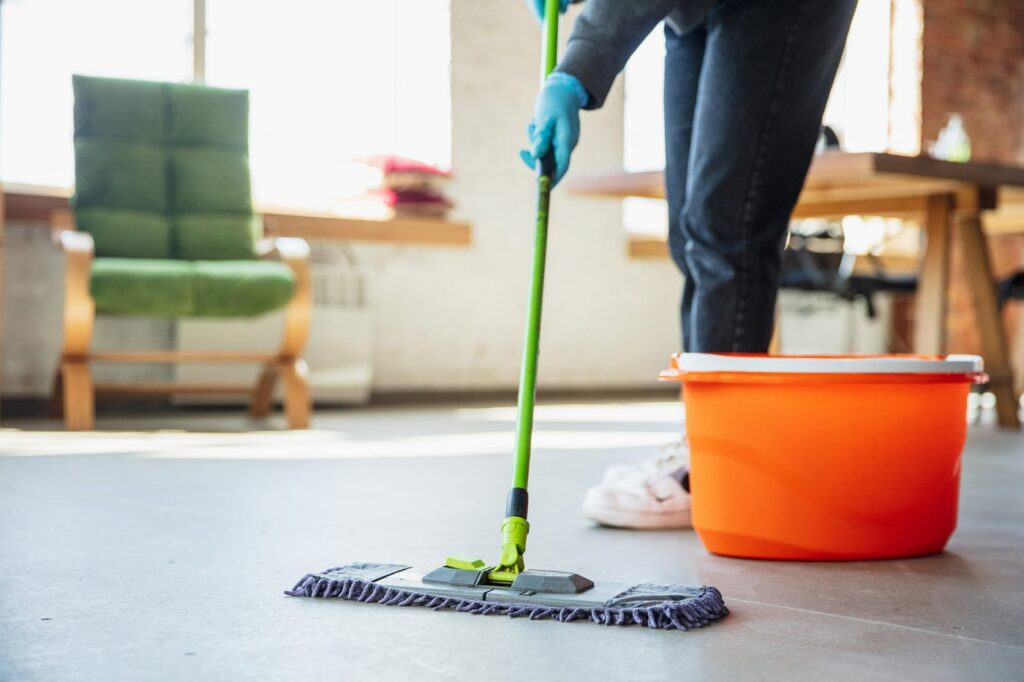
How to Professionally Deep Clean Tile Floors
Deep cleaning is a thorough, intensive cleaning that tackles neglected dirt and contaminants in areas not covered by regular cleaning.
Even ceramic tile installed with 100% epoxy grout must be deep cleaned occasionally to remove the build-up of dirt, grease, soap, and dirt to prevent grout discoloration.
- Prepare Your Cleaning Solution: After assessing the condition and requirements of the tile floor, dilute the appropriate cleaning product following the manufacturer’s instructions. Use warm water for better cleaning effectiveness.
- Apply the Solution: Use a mop or specialized tile cleaning tool to apply the cleaning solution evenly over the tile floor. Ensure thorough coverage while avoiding over-saturation.
- Scrub Gently: Employ a soft-bristle brush or a tile scrubber for stubborn stains. Use gentle, circular motions to loosen dirt and grime without damaging the tile surface.
- Rinse Thoroughly: Rinse clean water on the tile floor to remove any remaining cleaning solution. Repeat this step until the water runs clear to avoid any residue.
- Dry the Area: Use clean, dry mop heads or towels to absorb excess water and speed up drying. Adequate drying prevents slips and falls.
- Inspect and Touch Up: Inspect for any remaining stains or spots after drying. Spot treat as needed with the appropriate cleaning solution.
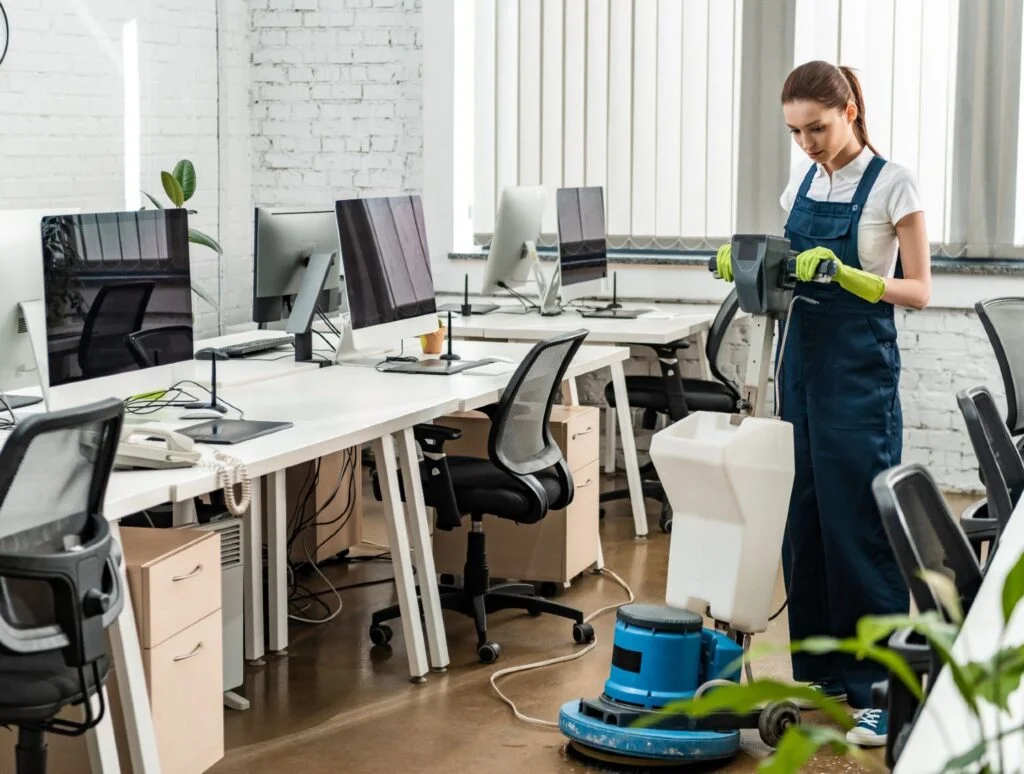
How to Clean Commercial Ceramic Tile Floors
Cleaning commercial tile floors is a straightforward process that, when done correctly, can keep your space looking pristine.
- Gather Your Supplies: Ensure you have the necessary supplies, including a mop, a bucket, warm water, and a pH-neutral ceramic tile floor cleaner.
- Remove Debris: To remove loose dirt and debris, begin by sweeping or vacuuming the tile floor. This prevents scratching during the cleaning process.
- Mix Cleaning Solution: Follow the manufacturer’s instructions for tile floor cleaning to mix the appropriate amount of cleaner with warm water in the bucket. Use a pH-neutral cleaner to avoid damaging the ceramic tiles.
- Mop the Floor: Dip the mop into the cleaning solution, wring it out, and mop the ceramic tile floor. Work in small sections, and avoid leaving excess water on the floor, which can cause streaks.
- Scrub Stains: For stubborn stains, use a soft-bristle brush or a cloth to scrub the affected area gently with the cleaning solution.
- Rinse: Empty the bucket and refill it with clean, warm water. Mop the floor again to remove any residue from the cleaning solution.
- Dry Thoroughly: Use a dry mop or towels to ensure the floor is arid. This step prevents slips and falls and maintains the tile’s shine.
5 Tips for Maintaining Your Commercial Tile Floors
Adopting simple daily maintenance practices is key to keeping your commercial tile floors looking their best.
- Place entrance mats at all entry points to trap dirt and moisture, preventing them from tracking onto the tile floor.
- Daily sweeping or vacuuming helps remove dirt and debris that can scratch the tile surface over time.
- Quickly address spills to prevent stains and slips. Use a clean cloth or paper towels for efficient cleanup.
- Schedule weekly mopping with a pH-neutral tile cleaner to remove accumulated grime. Rinse thoroughly with water.
- Periodic inspections help identify potential issues like cracked tiles or loose grout, allowing for timely repairs.
Common Mistakes to Avoid When Cleaning Tile Floors
Commercial tile floor cleaning may seem straightforward, but avoiding these common mistakes can make a significant difference in preserving their quality.
- Using harsh or acidic cleaners can damage tile surfaces. Stick to pH-neutral or manufacturer-recommended cleaning products to clean tile floors.
- Skipping routine maintenance allows dirt and stains to accumulate. Stick to a consistent cleaning schedule.
- Overwetting tile floors can cause water to seep into grout lines and cause damage. Always ensure thorough drying.
- Neglecting grout lines can result in discoloration and deterioration. Regularly clean and seal grout to prevent these issues.
- Using abrasive brushes or scouring pads that can scratch tile surfaces. Opt for soft-bristle brushes or microfiber mop heads.
Transform Your Workspace with Our Professional Tile Cleaning Services
Improve the cleanliness of your commercial space by following our best practices for cleaning commercial tile floors, including using appropriate cleaning products, deep cleaning techniques, and daily maintenance tips.
Don’t wait for stains and grime to take over. Contact Dallas Janitorial today to learn how our team can help you maintain a pristine, inviting environment with our professional tile cleaning services.
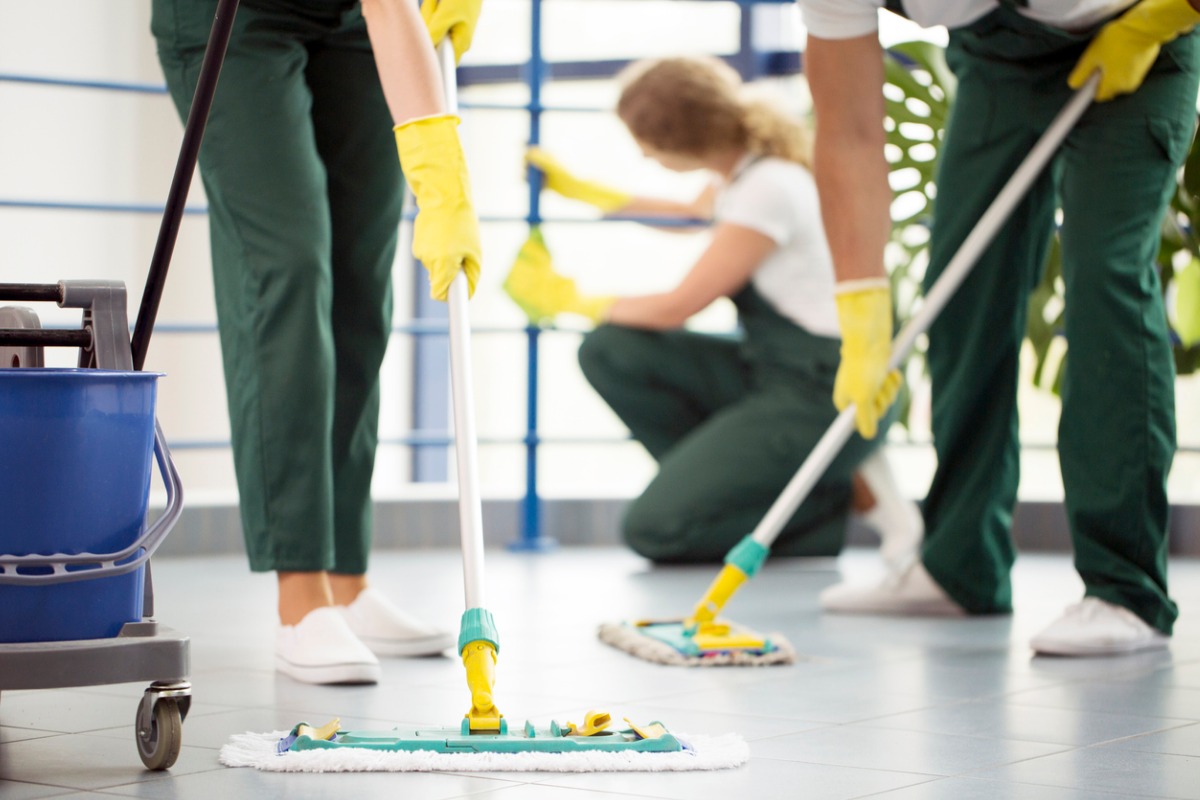
Frequently Asked Questions
How often should tile floors be cleaned?
Cleaning frequency depends on factors like foot traffic and usage patterns. High-traffic areas may need daily or weekly cleaning, while low-traffic areas can be cleaned less often, bi-weekly or monthly.
Why is it important to clean tile floors properly?
Properly cleaning tile floors is crucial because it enhances aesthetics, promotes health by removing allergens and bacteria, extends durability, ensures safety, and preserves the quality of the tiles.
How to clean commercial tile floors?
If you want to clean commercial tile floor stains on ceramic floors, begin by sweeping or vacuuming to remove debris. Then, mix a pH-neutral cleaner with warm water and mop the floor. Ensure to scrub stains gently. Afterward, rinse thoroughly and dry properly to prevent slips.
What do professionals use to clean tile floors?
Professionals use commercial-grade products and equipment, such as high-quality cleaners, specialized scrubbers, and powerful extractors. These tools ensure thorough cleaning, longevity, and a pristine appearance for tile floors.
What is the best way to clean dirty tile floors?
The best way to clean tile floors is to start with routine sweeping and mopping using a pH-neutral cleaner. For deep grime, use a soft-bristle brush or scrubber. Rinse and dry thoroughly to restore cleanliness.


